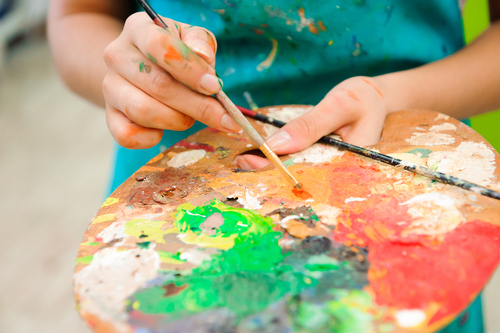British artist, Adrian Hill, coined the term ‘art therapy’ in 1942 after discovering the healthful benefits of drawing and painting while recovering from tuberculosis. Art therapy is currently recognized as an alternative form of psychotherapy that incorporates creative methods of expression by way of visual arts media. The American Art Therapy Association defines art therapy as “an integrative mental health and human services profession that enriches the lives of individuals, families, and communities through active art-making, creative process, applied psychological theory, and human experience within a psychotherapeutic relationship.” In short, art therapy acts as another means of communication. Unlike many traditional psychotherapeutic modalities, art therapy encourages participants to explore self-expression, emotions, and challenges through various art media rather than relying on one’s ability to accurately articulate verbally. Art therapy has been woven into treatment practices across the country and is often used in prisons, nursery schools, hospitals, nursing homes, and more. Art therapy allows individuals to process emotions and explore solutions to whatever they are experiencing through artistic expression.
Uses
Nowadays, art therapy is utilized in many areas of society, and depending on one’s needs, is considered a viable method of treatment for individuals ranging in age from toddlers to geriatrics. Art therapy may be used as a form of treatment for individuals with any of the following conditions:
- Anxiety
- Eating disorders
- Emotional difficulties
- Ageing-related issues
- Posttraumatic stress disorder (PTSD)
- Substance use disorder
- Family and/ or relationship problems
- Depression
- Cancer
- Psychological issues
Art therapists are trained mental health clinicians that are educated in human development, clinical practice, psychological theories, and fine art. Art therapy sessions can be conducted in an individual or group setting. Art therapy can be used on its own or in conjunction with other therapeutic treatment modalities.
Benefits
The mere fact that art therapy is a technique rooted in the notion that creative expression can foster healing and mental well being directly correlates with its efficacy. The benefits of art therapy are extensive. Some examples of the benefits of art therapy include, but are not limited to the following, as provided by the Canadian Counselling and Psychotherapy Association:
- Promotes self-reliance, personal independence, and self-sufficiency
- Enables an individual to verbally and nonverbally communicate emotions that may otherwise be abandoned
- Facilitates illuminating positive perspectives on one’s life
- Encourages the development of health coping strategies
- Promotes self-expression and self-discovery
- Acts as an emotional release
- Provides stress relief
- Improves self-esteem
- Increases resilience
Many individuals can be shy, or uncomfortable with their ability to properly articulate their emotions. Art therapy can serve as a language for those who need another way to identify, express, process and/ or work though challenges, thoughts, and emotions.
Disclaimer:
The information above is provided for the use of informational purposes only. The above content is not to be substituted for professional advice, diagnosis, or treatment, as in no way is it intended as an attempt to practice medicine, give specific medical advice, including, without limitation, advice concerning the topic of mental health. As such, please do not use any material provided above as a means to disregard professional advice or delay seeking treatment.



